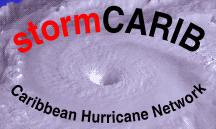
 |
Caribbean Hurricane Network- How close is it? - |
|
|
There is a storm brewing out there in the Atlantic, and you are wondering "How close is it?". Now you can accurately calculate the distance between the eye of the hurricane and your island. Just select your island (or if your island is not listed enter your coordinates) and hurricane specifics like, the latitude and longitude coordinates of the storm and click on 'Show me how close...'. You can use the U.S. Gazetteer to find latitude/longitude coordinates for US cities and zipcodes or the Astrodienst-website for World-wide queries (results have to be converted from dd:mm:ss-format). A related tool on this website (How close can it get?) calculates the closest point of approach given the 5-day forecast.
In addition, you can enter the forward speed at which the hurricane is moving to calculate the time before the eye makes landfall at your location. If you know how far tropical storm winds extend from the center of the storm you can enter those as well to calculate how much preparation time you have left before winds will be blowing at tropical storm force. Caution: the numbers you get will only be true if the hurricane will travel in a straight line to your island at a constant speed and when you assume that the wind field doesn't change, in other words, the hurricane doesn't strengthen or weaken, over that time [this is normally not the case!!!].
|
For people living in threatened areas of the United States, I have compiled a list with the latitude/longitude coordinates of many of the cities on the coast of Gulf of Mexico, plus some larger cities in Florida. The latitude/longitude can then be entered in the 'Or enter your Coordinates' section. See here (pop-up). By the way, Corpus Christi is at 27.71N, 97.29W, Houston at 29.80N, 95.39W, New Orleans at 30.07N, 89.93W, Pensacola at 30.44N, 87.19W, Panama City at 30.17N, 85.67W, Tampa at 28.0N, 82.5W and Cape Coral at 26.6N, 82.0W. -Gert |
Currently Tracking:
300 PM GMT Mon Nov 04 2024
: Remnants of Patty ... 38.5 N, 16.2 W ... max. winds 35 mph ... movement ene near 17 mph ... [more]